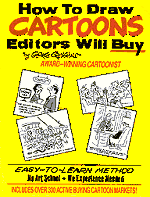 Are you even a little bit interested
in doing panel-gag cartoons for magazines? It’s supposed to be the easiest
way for a new artist to start earning money from cartoons and building a
professional resumé. If this sounds good to you, run, do not walk, to
the following link and order
How to Draw Cartoons Editors Will Buy by George Crenshaw!
This book is crammed with hard-nosed, practical, all-business, no-nonsense
advice from a pro with credentials as long as your arm! He has aimed this
book to get you selling quality comics in the minimum time --
and all this without selling your soul or cloning your art!
Are you even a little bit interested
in doing panel-gag cartoons for magazines? It’s supposed to be the easiest
way for a new artist to start earning money from cartoons and building a
professional resumé. If this sounds good to you, run, do not walk, to
the following link and order
How to Draw Cartoons Editors Will Buy by George Crenshaw!
This book is crammed with hard-nosed, practical, all-business, no-nonsense
advice from a pro with credentials as long as your arm! He has aimed this
book to get you selling quality comics in the minimum time --
and all this without selling your soul or cloning your art!The most striking thing about this book is the confidence with which Crenshaw has written it; it’s like he knows these tips and techniques inside out cuz they’ve been working for him for decades, so he has total faith in what he teaches. A vastly inspiring, uncommonly practical, super-useful book! Note: this one finally got me off my duff to take a shot at the magazines myself -- I’ll let you know if anything interesting happens...
UPDATE!! -- I sent out a batch of ten cartoons to a magazine; they came back. I sent the same batch out to a different magazine; they bought three of the ten! These are the kind of quick results that Crenshaw’s book talks about -- it worked for me!!
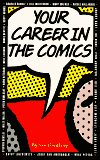 However, if comic strips [and their potential for vast wealth!] are more to your liking, you have to read
Your Career in the Comics by Lee Nordling. This excruciatingly excellent book examines every aspect of doing a syndicated strip: from ideas and planning and tool talk to contracts and promotion and a lot of business things that maybe you never thought of -- but you’ll soon see how crucial everything is, how it all connects. And the info is assembled by quoting directly from the professionals involved: syndicate guys, newspaper editor, agents, strip salesmen, and of course cartoonists -- including luminaries such as Charles Schulz, Scott Adams, Bill Watterson, Bil Keane, Hank Ketcham, Lynn Johnston, Bill Amend, and many more. The chance to learn from the experiences of so many top-of-the-field creators is too good to pass up -- this is meaty, enlightening, and often surprising sutff. Absolutely essential if you wanna get syndicated!
However, if comic strips [and their potential for vast wealth!] are more to your liking, you have to read
Your Career in the Comics by Lee Nordling. This excruciatingly excellent book examines every aspect of doing a syndicated strip: from ideas and planning and tool talk to contracts and promotion and a lot of business things that maybe you never thought of -- but you’ll soon see how crucial everything is, how it all connects. And the info is assembled by quoting directly from the professionals involved: syndicate guys, newspaper editor, agents, strip salesmen, and of course cartoonists -- including luminaries such as Charles Schulz, Scott Adams, Bill Watterson, Bil Keane, Hank Ketcham, Lynn Johnston, Bill Amend, and many more. The chance to learn from the experiences of so many top-of-the-field creators is too good to pass up -- this is meaty, enlightening, and often surprising sutff. Absolutely essential if you wanna get syndicated!
 Syndicated cartoonist, magazine mainstay, advice columnist, all-American good guy and devil-may-care flying fool
Randy Glasbergen has also authored three of the best cartooning books ever:
Getting Started Drawing and Selling Cartoons,
How to Be a Successful Cartoonist and
Toons!
Syndicated cartoonist, magazine mainstay, advice columnist, all-American good guy and devil-may-care flying fool
Randy Glasbergen has also authored three of the best cartooning books ever:
Getting Started Drawing and Selling Cartoons,
How to Be a Successful Cartoonist and
Toons!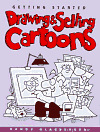 My penpal Perry and I have formulated a
rule about books on cartooning: to avoid getting sued, I will refer to it here only as
“M’s Law”. M’s Law states that “any substantial book on how to draw cartoons
will be written by an artist you never heard of before, whose own art is particularly
average and uninspiring”. (Makes a kind of sense: you’d expect a really good
cartoonist to be too busy drawing and selling cartoons to write a book, right?)
My penpal Perry and I have formulated a
rule about books on cartooning: to avoid getting sued, I will refer to it here only as
“M’s Law”. M’s Law states that “any substantial book on how to draw cartoons
will be written by an artist you never heard of before, whose own art is particularly
average and uninspiring”. (Makes a kind of sense: you’d expect a really good
cartoonist to be too busy drawing and selling cartoons to write a book, right?)I mention this here only to point out that Randy Glasbergen is The Greatest Exception to M’s Law -- you can spot his strong, economical, supremely confident linework a mile away,
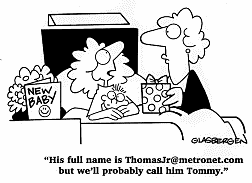 he’s had sutff in like every magazine in the world for decades,
[for that matter,
check out what he’s just done today!],
and I’ve admired his work all that time.
Yet somehow he made the time to grace us with not one but three
good books on cartooning! [Wanna bet he wears a mask and cape?]
he’s had sutff in like every magazine in the world for decades,
[for that matter,
check out what he’s just done today!],
and I’ve admired his work all that time.
Yet somehow he made the time to grace us with not one but three
good books on cartooning! [Wanna bet he wears a mask and cape?]

 Packed with solid
advice, much of which I’d never heard before, and lotsa tips ’n’ interviews with
other “real” cartoonists. And bonus points
Packed with solid
advice, much of which I’d never heard before, and lotsa tips ’n’ interviews with
other “real” cartoonists. And bonus points
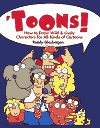 to Randy for not implying that
his own style or techniques are somehow superior: he encourages you to be the
best you-cartoonist you can be. Even more bonus points for
producing three books, each of which succeeds as a starting point for the
would-be cartoonist, yet each of which overlaps the others in very few
places: Randy did not simply rehash the same book a couple times!
Man, how does he do this?!!
to Randy for not implying that
his own style or techniques are somehow superior: he encourages you to be the
best you-cartoonist you can be. Even more bonus points for
producing three books, each of which succeeds as a starting point for the
would-be cartoonist, yet each of which overlaps the others in very few
places: Randy did not simply rehash the same book a couple times!
Man, how does he do this?!!I guess the tough part is deciding which of Randy’s books to get first! [Sorry, I can’t help ya there: I just went ahead and got all of ’em, and consider each one to be an excellent investment.]
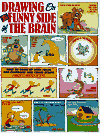 Christopher Hart’s name appears a couple times in our newbie section, but he’s not just a beginner’s author, as his
Drawing on the Funny Side of the Brain will prove. This is one of the better, and more advanced, cartooning books out there. While it does go over yer usual “stick-man” first steps briefly, most of it is devoted to addressing sutff like panel layout, strip breakdowns, consistency of character design, timing in humor writing, marketing your work, etc. In every case, Hart speaks from experience: apparently he has written stand-up and TV comedy professionally, as well as doing animation, comic books, strips, and piloting the space shuttle. [I’m just guessing at that last one, but don’t be surprised... ]
Christopher Hart’s name appears a couple times in our newbie section, but he’s not just a beginner’s author, as his
Drawing on the Funny Side of the Brain will prove. This is one of the better, and more advanced, cartooning books out there. While it does go over yer usual “stick-man” first steps briefly, most of it is devoted to addressing sutff like panel layout, strip breakdowns, consistency of character design, timing in humor writing, marketing your work, etc. In every case, Hart speaks from experience: apparently he has written stand-up and TV comedy professionally, as well as doing animation, comic books, strips, and piloting the space shuttle. [I’m just guessing at that last one, but don’t be surprised... ]Anyhoo, if you’ve advanced in your cartoons to the point where you’re considering getting into the pool of publication, this book is a good resource for polishing and fine-tuning what you can do.
 Draw 50 Famous Cartoons by Lee J. Ames. On the surface,
this looks like one of those books “serious” artists avoid -- y’know, step-by-step
instructions on how to draw something from only one angle and that’s the only view
you ever learn to do? That’s what I thought of this one at first, myself. But when
I looked a little closer, I saw valuable lessons here for (believe it or not) a
more advanced artist. The thing is, Ames (who has written more Draw 50
books than you can imagine) shows his step-by-step roughs for drawing each comic
character here... and they’re all different. That is what amazed me: he
doesn’t have any one pet way to begin drawing a figure. To see how many different
structures will work as the “skeleton” for a comic character is... well,
illuminating, I guess. If you’ve developed enough skill to be able to visualize
Ames’s roughs in three dimensions, and apply them to a character from all
angles, then this book can broaden your structural vocabulary enormously!
Worth a look...
Draw 50 Famous Cartoons by Lee J. Ames. On the surface,
this looks like one of those books “serious” artists avoid -- y’know, step-by-step
instructions on how to draw something from only one angle and that’s the only view
you ever learn to do? That’s what I thought of this one at first, myself. But when
I looked a little closer, I saw valuable lessons here for (believe it or not) a
more advanced artist. The thing is, Ames (who has written more Draw 50
books than you can imagine) shows his step-by-step roughs for drawing each comic
character here... and they’re all different. That is what amazed me: he
doesn’t have any one pet way to begin drawing a figure. To see how many different
structures will work as the “skeleton” for a comic character is... well,
illuminating, I guess. If you’ve developed enough skill to be able to visualize
Ames’s roughs in three dimensions, and apply them to a character from all
angles, then this book can broaden your structural vocabulary enormously!
Worth a look... Some skimming might be required on this one, but there’s some unique and meaty sutff to be found in The Merchant of Dennis the Menace, the autobiography of [naturally] Hank Ketcham. Ketcham is a unique and all-time-great comic stylist, and in this book he offers insights on the writing process, approaches to seeing and drawing, tool talk, etc. As for the personal chat, some of it is art-oriented [e.g., his years at Disney --- yes, another one!] and pretty cool. If you don’t dig golf or fishing, you might find certain chunks of this book skippable. [And personally, I’m extremely curious how an autobiography can tell you more about the person’s garden landscaping than about his family; Ketcham barely mentions his (in)famous son Dennis, believe it or not.] Still, we are treated to one-of-a-kind insights from a one-of-a-kind creator [I promise you’ll be staggered by how well Ketcham knows his characters and how much work has gone into making them live!], and there are lotsa samples of his gorgeous line drawings, so overall this one is well worth it.